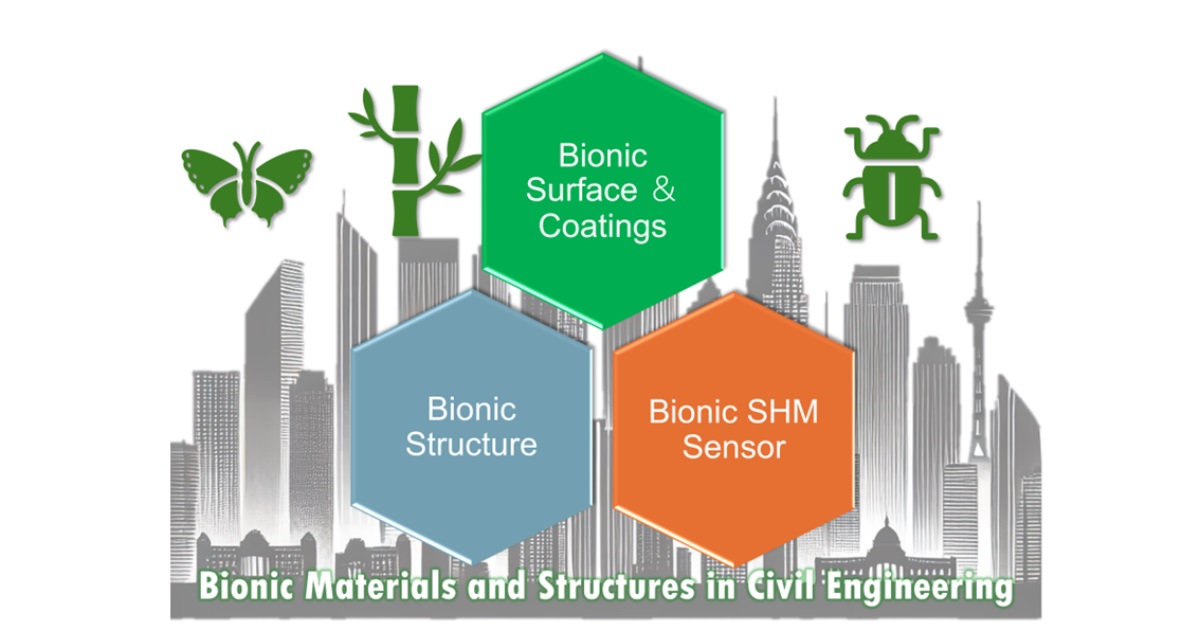Bionic Materials and Structures in Civil Engineering
A special issue of Buildings (ISSN 2075-5309). This special issue belongs to the section "Building Structures".
Deadline for manuscript submissions: 31 December 2025 | Viewed by 3866

Special Issue Editors
Interests: biomimetic lightweight structure; beetle elytron plate; biomimetic material; hollow slab system; lightweight straw wall panel; high-strength fiber-reinforced composite material
Special Issues, Collections and Topics in MDPI journals
Interests: bio-inspired structure; structural health monitoring; curved beetle elytron plate; nano composite strain sensor
Special Issues, Collections and Topics in MDPI journals
Special Issue Information
Dear Colleagues,
We are pleased to announce this Special Issue of Buildings, entitled “Bionic Materials and Structures in Civil Engineering”. As the demand for sustainable and resilient construction grows, bio-inspired designs and materials have emerged as innovative solutions that draw from nature’s principles to enhance structural performance and efficiency.
Bionic materials and structures mimic biological forms and mechanisms, offering significant advantages in terms of strength, adaptability, and energy efficiency. Practical examples include honeycomb panels inspired by beehive or beetle elytron structures, widely applied in construction components due to their high strength-to-weight ratio and excellent energy absorption capacity. Another example is buildings mimicking the ventilation and cooling systems of ant mounds, which significantly enhance airflow efficiency in hot environments to maintain indoor comfort. Similarly, insulation materials inspired by polar bear fur, with porous internal structures, effectively isolate external low temperatures, providing exceptional thermal insulation for buildings.
Moreover, many structural designs are directly inspired by the shapes and functions found in nature. For instance, cable-stayed structures mimicking spider webs, as seen in the Munich Olympic Stadium, combine lightweight and strong tensile properties, reducing material usage significantly. Thin-shell structures, drawing inspiration from natural forms such as eggshells and seashells, use curved surfaces to achieve maximum load-bearing capacity with minimal material consumption. The renowned “Water Cube” building, based on foam theory, uses a multi-cellular structure to achieve efficient thermal regulation and structural support.
However, incorporating these bionic principles into civil engineering applications still faces challenges, including scalability, cost-efficiency, and integrating complex biological mechanisms into conventional construction methods. This Special Issue aims to address these challenges by showcasing original research and cutting-edge technologies in the field.
We invite contributions that explore the latest advancements in bionic design, material development, and structural optimization for civil engineering applications. Specific research topics include, but are not limited to, the following:
- Bionic lightweight structural components: Design and optimization of honeycomb beams, sandwich plates, and bio-inspired columns.
- Bionic surfaces and coatings: Development of self-cleaning surfaces, anti-fouling coatings, and thermal insulating materials.
- Bionic sensors for structural health monitoring: Design of bio-inspired sensors for damage detection, stress monitoring, and maintenance forecasting.
- Bionic foundations and substructures: Application of root-like geometries and burrow-inspired designs for enhanced stability and load distribution.
- Bionic optical structures: Daylighting systems, bio-inspired façades, and nature-based light-guiding designs to optimize indoor lighting.
- Bionic algorithms and intelligent design: Utilization of swarm intelligence, fire evacuation models, and nature-inspired optimization techniques.
- Sustainable building technologies: Integration of energy-saving strategies, low-carbon solutions, and eco-friendly material innovations.
We look forward to receiving your innovative submissions that contribute to the growing body of knowledge in bionic engineering and push the boundaries of what is possible in civil engineering.
You may choose our Joint Special Issue in Materials.
Prof. Dr. Jinxiang Chen
Dr. Yiheng Song
Guest Editors
Manuscript Submission Information
Manuscripts should be submitted online at www.mdpi.com by registering and logging in to this website. Once you are registered, click here to go to the submission form. Manuscripts can be submitted until the deadline. All submissions that pass pre-check are peer-reviewed. Accepted papers will be published continuously in the journal (as soon as accepted) and will be listed together on the special issue website. Research articles, review articles as well as short communications are invited. For planned papers, a title and short abstract (about 250 words) can be sent to the Editorial Office for assessment.
Submitted manuscripts should not have been published previously, nor be under consideration for publication elsewhere (except conference proceedings papers). All manuscripts are thoroughly refereed through a single-blind peer-review process. A guide for authors and other relevant information for submission of manuscripts is available on the Instructions for Authors page. Buildings is an international peer-reviewed open access semimonthly journal published by MDPI.
Please visit the Instructions for Authors page before submitting a manuscript. The Article Processing Charge (APC) for publication in this open access journal is 2600 CHF (Swiss Francs). Submitted papers should be well formatted and use good English. Authors may use MDPI's English editing service prior to publication or during author revisions.
Keywords
- bionic structures
- bio-inspired materials
- sustainable building technologies
- bionic surfaces and coatings
- structural health monitoring
- bionic optical systems
- lightweight construction components
- bionic sensors
- nature-inspired algorithms
- energy-efficient design
Benefits of Publishing in a Special Issue
- Ease of navigation: Grouping papers by topic helps scholars navigate broad scope journals more efficiently.
- Greater discoverability: Special Issues support the reach and impact of scientific research. Articles in Special Issues are more discoverable and cited more frequently.
- Expansion of research network: Special Issues facilitate connections among authors, fostering scientific collaborations.
- External promotion: Articles in Special Issues are often promoted through the journal's social media, increasing their visibility.
- Reprint: MDPI Books provides the opportunity to republish successful Special Issues in book format, both online and in print.
Further information on MDPI's Special Issue policies can be found here.






